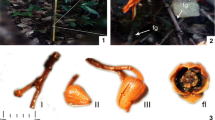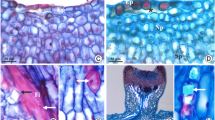Abstract
Brosimum alicastrum Sw, known in Mexico as the Ramón nut, is a sustainable resource in the economy of Yucatan, Mexico; the pulp and seed are edible, and the latter is very nutritious when consumed whole or ground into corn or wheat flour to make tortillas and bread. Because the inflorescences are an essential source of Moraceae taxonomic traits, the histochemistry of the floral parts, fruit, and seed of B. alicastrum was studied to establish their structural characteristics and chemical nature. Different developmental stages of the structures were studied with anatomical and histochemical techniques and scanning electron microscopy. The species presented three achlamydeous floral morphs: (a) uniflorous, unisexual pistillate inflorescence, with the ovary embedded in the receptacle, and exposing a style with bifurcate stigma; (b) unisexual staminate inflorescence with flowers with one stamen, a straight and thick filament, a bilocular peltate anther, with fused theca and circumscissile dehiscence, characteristics that define it as Brosimum alicastrum Sw. subsp. alicastrum CC Berg; and (c) bisexual inflorescence with staminate flowers and a pistillate flower with an atrophied ovule. The fleshy and sweet pulp is derived from the receptacle containing glycoproteins and idioblasts. The endocarp, which derives from the ovary wall, has a coriaceous consistency, so the fruit is classified as a pome. Thick and unequal fleshy cotyledons with laticifers, proteinoplasts, amyloplasts, and idioblasts; endosperm is absent from the mature seed; a thin and lignified seed coat surrounds them. The nutritional characteristics of the fruit and seed were corroborated with positive reactions of histochemical techniques.



Similar content being viewed by others
References
Acosta A, Martínez-Ruiz N (2017) Desarrollo de una bebida nutritiva y sensorialmente agradable como suplemento en el desayuno de niños escolares. Rev Esp Nutr Comunitaria 23:1–9
Anantaswamy Rau M (1942) Development of the embryo sac and embryo in Streblus asper. Lour J Mysore Univ 2:109–114
Araujo LM, Valentin-Silva A, Fernandes GW, Viera MF (2017) From anthesis to diaspore dispersal: reproductive mechanisms of rare herbaceous Moraceae species endemic to Brazil. Darwiniana 5:83–92
Baleroni CRS, Moraes MLT, Moraes SMB, Souza CS, Sá ME (2002) Composição química de sementes das espécies florestais Mamica-de-cadela (Brosimum gaudichaudii Trec), Marolo arbóreo (Annona crassiflora Mart.), Marolo rasteiro (Annona dióica St. Hil.), Chichá-do-cerrado (Sterculia A St. Hil. ex Turpin) e Imbuia (Ocotea porosa (Nees) L. Barroso). Ciên Agr Saúde 2:28–32
Banerji I, Hakim A (1954) A contribution to the life-history of Artocarpus lakoocha Roxb. Proc Indian Acad Sci Sect B 39:128–132
Batygina TB (2002) Embryology of flowering plants. Terminology and concepts, vol 1. Generative organs of flower. Science Publishers, Inc., Shropshire, UK
Berg CC (1972) Olmedieae Brosimeae (Moraceae). Flora Neotrop 7:1–228
Berg CC (2001) Moreae, Artocarpeae, and Dorstenia (Moraceae): with introductions to the family and Ficus and with additions and corrections to Flora Neotropica Monograph 7. Organ Flora Neotropica 83:1–346
Berg CC (2005) Moraceae diversity in a global perspective. Biol Skr 55:423–440
Berg CC, Corner EJH, Jarrett FM (2006) Moraceae, genera other than Ficus. Fl Males 17:1–152
Bozzola JJ, Russell LD (1999) Electron Microscopy: principles and techniques for biologists, 2a edn. Jones & Bartlett Publishers, Boston USA, p 670
Burn MJ, Mayle FE (2008) Palynological differentiation between genera of the Moraceae family and implications for Amazonian palaeoecology. Rev Palaeobot Palynol 149:187–201
Carvajal S (2007) Moraceae. Flora del Bajío y de Regiones adyacentes 147:1–59
Chase MW, Christenhusz MJM, Fay MF, Byng JW, Judd WS, Soltis DE et al (2016) An update of the angiosperm phylogeny group classification for the orders and families of flowering plants: APG IV. Bot J Linn Soc 181:1–20
Classen-Bockhoff R (1990) Pattern analysis in pseudanthia. Pl Syst Evol 171:57–88
Clement WL, Weiblen GD (2009) Morphological evolution in the Mulberry family (Moraceae). Syst Bot 34:530–552
Corner EJH (1962) The classification of Moraceae. Gard Bull Singap 19:187–252
Datwyler SL, Weiblen GD (2004) On the origin of the fig: phylogenetic relationships of Moraceae from ndhF sequences. Am J Bot 91:767–777
Endress PK (1994) Diversity and evolutionary biology of tropical flowers. Cambridge University Press, Cambridge, UK
Endress PK (2011) Evolutionary diversification of the flowers in angiosperms. Am J Bot 98:370–396
Endress PK (2019) The morphological relationship between carpels and ovules in angiosperms: pitfalls of morphological interpretation. Bot J Linn Soc 189:201–227
Esau K (1977) Anatomy of seed plants. Wiley, New York
Font Quer P (1965) Diccionario de Botánica. Labor, Barcelona, España
Jacomassi E, Rodrigues MIS, Machado S (2010) Morfoanatomia e histoquímica de órgãos reprodutivos de Brosimum gaudichaudii (Moraceae). B J Bot 33:115–129
Johansen DA (1940) Plant microtechnique. McGraw-Hill Book Company Inc, New York
Larqué-Saavedra FA (2014) El sector forestal en apoyo a la “Cruzada contra el Hambre”. La inclusión de Brosimum alicastrum (Ramón) como estudio de caso. Forestal XXI 11:11–12
Le Floc’h N, Seve B (2007) Biological roles of tryptophan and its metabolism: potential implications for pig feeding. Livest Sci 112:23–32
Leite VG, Freitas Mansano V, Pádua Texeira S (2018) Floral deveploment of Moraceae species with emphasis on the perianth and androecium. Flora 240:116–132
Leite VG, Basso-Alves JP, Gualberto ARS, Teixeira SP (2020) A comparative ontogenetic approach to understanding the pseudomonomerous gynoecium in Moraceae. Int J Plant Sci 181:241–245
Martínez-Ruiz NR, Torres LEJ, del Hierro-Ochoa JC, Larqué-Saavedra A (2019) Bebida adicionada con Brosimum alicastrum Sw.: una alternativa para requerimientos dietarios especiales. RESPYN 18:1–10
Meiners M, Sánchez Garduño C, De Blois S (2009) El ramón: fruto de nuestra cultura y raíz para la conservación. Biodiversitas 87:7–10
Morales Ortiz ER, Herrera Tuz LG (2009) RAMON (Brosimum alicastrum Swartz.) Protocolo para su colecta, beneficio y almacenaje. Comisión Nacional Forestal. Región XII Península de Yucatán, pp 1–17 Departamento de Conservación y Restauración de Ecosistemas Forestales. Programa de Germoplasma Forestal. Estado de Yucatán,
Niembro A (1989) Semillas de plantas leñosas. Morfología comparada. Editorial Limusa, México
Oyama SO, Souza LA (2011) Morphology and anatomy of the developing fruit of Maclura tinctoria, Moraceae. B J Bot 34:187–195
Ozer HK (2017) Phenolic compositions and antioxidant activities of Maya nut (Brosimum alicastrum): comparison with commercial nuts. Int J Food Prop 20:2772–2781
Pardo-Tejeda E, Sánchez-Muñoz C (1981) Brosimum alicastrum: a potentially valuable tropical forest resource (No. Folleto 4721Y). Instituto Nacional de Investigaciones sobre Recursos Bióticos. México.
Pennington TD, Sarukhán J (1998) Árboles Tropicales de México. Manual para la identificación de las principales especies. Universidad Nacional Autónoma de México. Fondo de Cultura Económica. México.
Peters CM, Pardo-Tejeda E (1982) Brosimum alicastrum (Moraceae): uses and Potential in Mexico. Econ Bot 36:166–175
Pratt C (1988) Apple flower and fruit: morphology and anatomy. Hortic Rev 10:273–308
Rohwer JG, Berg CC (1993) Moraceae. In: Kubitzki K, Rohwer JG, Bittrich V (eds) Flowering plants. Dicotyledons. The families and genera of vascular plants. Springer, Berlin, pp 438–452
Romaniuc-Neto S, Wanderley MGL (1992) Flora fanerogâmica da reserva do Parque Estadual das Fontes do Ipiranga (São Paulo, Brasil) 19-Moraceae. Hoehnea 19:165–169
Roth I (1977) Fruits of angiosperms. Encyclopedia of plant anatomy. Gebruder Borntreger, Berlin
Schmid R (1976) Filament histology and anther dehiscence. Bot J Linn Soc 73:303–315
Silva DB, Vieira RF, Cordeiro MCT, Pereira EBC, Pereira AV (2011) Propagação vegetativa de Brosimum gaudichaudii Tréc. (mama-cadela) por estacas de raízes. Rev Bras Plantas Med 13:151–156
Sokoloff DD, Nuraliev MS, Oskolski AA, Remizowa MV (2017) Gynoecium evolution in angiosperms: monomery, pseudomonomery, and mixomery. Moscow Univ Biol Sci Bull 72:97–108
Solereder H, Scott DH (1908) Systematic anatomy of the dicotyledons: a handbook for laboratories of pure and applied botany, vol 2. Clarendon Press, Oxford, UK
Souza LA, Rosa SM (2005) Morfo-anatomia do fruto em desenvolvimento de Sorocea bonplandii (Baill.) Burger, Lanjow & Boer (Moraceae). Acta Sci Biol Sci 27:423–428
Subiria-Cueto R, Larqué-Saavedra A, Reyes-Vega ML, de la Rosa LA, Santana-Contreras LE, Gaytán-Martínez M et al (2019) Brosimum alicastrum Sw. (Ramón): an Alternative to improve the Nutritional Properties and functional Potential of the Wheat Flour Tortilla. Foods 8:2–18
Tokpunar HK (2010) Chemical composition and antioxidant properties of maya nut (Brosimum alicastrum). Doctoral dissertation, Clemson University
Vázquez-Yanes C, Batis-Muñoz AI, Alcocer-Silva MI, Gual-Díaz M, Sánchez-Dirzo C (2001) Árboles y arbustos nativos potencialmente valiosos para la restauración ecológica y la reforestación. Instituto de Ecología, Universidad Nacional Autónoma de México, México DF, México
Acknowledgments
The authors thank the following academic staff of the UNAM Faculty of Sciences: Ana Isabel Bieler-Antolin for camera and microscope assistance, Ricardo García Sandoval for edition of figures, Lucía Yoscelina Centeno Betanzos for histochemical technical support, and Martha Juana Martínez-Gordillo and Sonia Vázquez-Santana for helpful comments.
Author information
Authors and Affiliations
Contributions
KPR research on reports about the plant, establishment of the histochemical techniques. GLH, AFLS, and AEBF design of the work, interpretation of the results, their discussion, and manuscript writing and editing. SEM scanning electron microscope assistance, image analysis, and interpretation. All authors read and approved the final manuscript.
Corresponding author
Ethics declarations
Conflict of interest
The authors declare that they have no conflicts of interest.
Additional information
Publisher's Note
Springer Nature remains neutral with regard to jurisdictional claims in published maps and institutional affiliations.
Alicia Enriqueta Brechú-Franco, Guillermo Laguna-Hernández and Karen Pasillas-Rodríguez: Part of Karen Pasillas Rodríguez's Bachelor Thesis to obtain the title of Biologist.
Rights and permissions
About this article
Cite this article
Brechú-Franco, A.E., Larqué-Saavedra, A.F., Laguna-Hernández, G. et al. Morphology, structure, and histochemistry of the inflorescences, fruit, and seed of the Ramón nut, Brosimum alicastrum Sw. subsp. alicastrum CC Berg (Moraceae). Braz. J. Bot 44, 457–466 (2021). https://doi.org/10.1007/s40415-021-00708-w
Received:
Revised:
Accepted:
Published:
Issue Date:
DOI: https://doi.org/10.1007/s40415-021-00708-w




